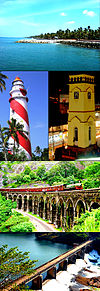Neendakara: Difference between revisions
m (→Other websites: Add {{source}} tag) |
WikiDwarfBOT (talk | contribs) m (→Other websites: Replace {{Source}} tag) |
||
| Line 80: | Line 80: | ||
==Other websites== | ==Other websites== | ||
{{commons category-inline}} | {{commons category-inline}} | ||
| Line 87: | Line 87: | ||
[[Category:Villages in India]] | [[Category:Villages in India]] | ||
[[Category:Settlements in Kerala]] | [[Category:Settlements in Kerala]] | ||
{{simple-Wikipedia}} | |||
Latest revision as of 15:48, 1 May 2021
Neendakara | |
|---|---|
Urban Village | |
 Neendakara Port, Kollam | |
| Coordinates: 8°56′19″N 76°32′25″E / 8.93861°N 76.54028°ECoordinates: 8°56′19″N 76°32′25″E / 8.93861°N 76.54028°E | |
| Country | |
| State | Kerala |
| District | Kollam |
| Languages | |
| • Official | Malayalam, English |
| Time zone | UTC+5:30 (IST) |
| PIN | 691582 |
| Telephone code | 0476 |
| Vehicle registration | KL-23, KL-02 |
| Nearest city | Kollam City (9 km) |
| Climate | Tropical monsoon (Köppen) |
| Avg. summer temperature | 35 °C (95 °F) |
| Avg. winter temperature | 20 °C (68 °F) |
Neendakara is a village in Karunagappally taluk, Kollam district, Kerala, India.[1] It is Kollam district's medium fishing port.
History[edit]
When Portuguese traders settled in Kollam in the early 16th century, their ships passed through the Neenadakara bar, now the site of Neendakara Bridge, part of National Highway 66, which connects the village to Sakthikulangara across Ashtamudi Lake.
Etymology[edit]
In Malayalam, Neendakara means "a long bank".[2]
Norwegian Project[edit]
The headquarters of the Indo-Norwegian Fisheries Community project, established in 1953, was based in Neendakara until 1961, when the site was handed over to the Government of Kerala.[3]
References[edit]
- ↑ [1] Kollamnic.in|Villages in Karunagappally Taluk
- ↑ Gulati, Leela (1984). Fisherwomen on the Kerala Coast: Demographic and Socio-economic Impact of a Fisheries Development Project. International Labour Organisation. p. 48. ISBN 978-92-2-103626-5. Retrieved 2009-05-20.
- ↑ "History". National Institute of Fisheries Post Harvest Technology and Training. Retrieved 2009-05-20.
Other websites[edit]


